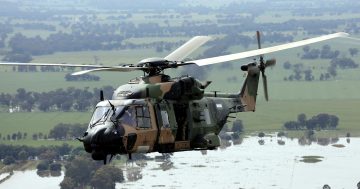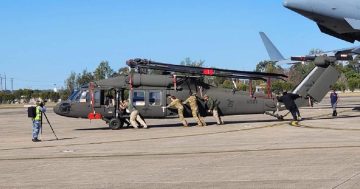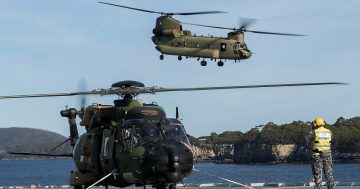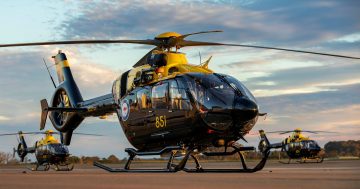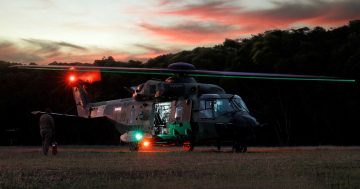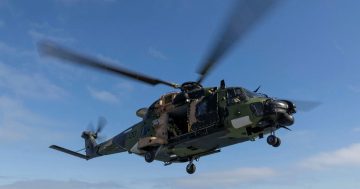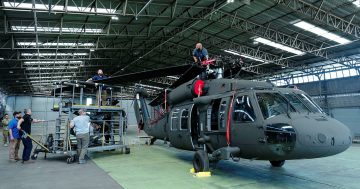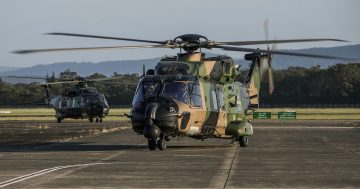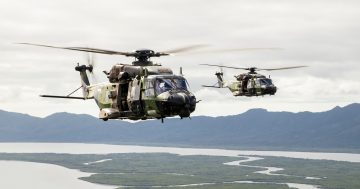
The MRH 90 has had a troubled service life with the ADF and will now not be returned to service. Photo: ADF
The Australian Army’s fleet of 46 Airbus MRH 90 Taipan helicopters, which have been grounded since a fatal crash on 28 July, will not return to service.
The crash occurred during a night phase of Exercise Talisman Sabre, where the aircraft involved in the accident was part of a larger force of aircraft that had just dropped a special forces group onto an island. It was flying at high speed and low level over the ocean near Lindeman Island in the Whitsundays at the time of the crash.
The aircraft was destroyed when it hit the water, and its four crewmen from No 173 Squadron of the Sydney-based No 6 Aviation Regiment (6Avn) – pilots Captain Daniel Lyon and Lieutenant Maxwell Nugent, and loadmasters Warrant Officer Class 2 Joseph Laycock and Corporal Alexander Naggs – were killed.
Despite initially saying the fleet would be grounded pending the outcome of an investigation of the crash, the government has decided to withdraw the MRH 90 from service. It says the move “does not presuppose or in any way suggest the outcome of the investigations”, but added that the “investigations are likely to continue well into 2024”.
The MRH 90 entered service between 2008 and 2011. They were meant to serve through to the mid-2030s. When ordered, the MRH 90 offered greater capacity and more range than its competitors – including the Black Hawk – and its manufacturers offered an attractive Australian Industry Content (AIC) plan that included manufacturing all but the first couple of aircraft in Australia.
But the aircraft’s service introduction was delayed, and the fleet has been grounded several times since it entered service due to various problems, including the delamination of a composite tail rotor and an inability to track the provenance and history of refurbished components coming back to the Australian fleet from the global supply chain. There have also been difficulties in adapting and configuring the aircraft for the special forces support role.
The MRH 90 thus remained on the Government’s Projects of Concern list for most of its short service life. Therefore, in 2021, it was announced it would be replaced by the Sikorsky UH-60M Black Hawk – the aircraft it originally beat out for the Project AIR 9000 Phase 2/4 requirement in 2006 – from late 2024 due to its ongoing poor availability and configuration management issues.
“The MRH-90 has been an important capability for our country and Defence Force, and I recognise the hard work of the hundreds of people who dedicated themselves to acquiring, operating and sustaining the aircraft,” Deputy Prime Minister and Defence Minister Richard Marles said in a statement.
The early retirement will mean the Australian Army will have a massive shortfall in transport capacity, one that will take several years to fill as the new Black Hawks enter service. The first three of 40 new Black Hawks were delivered to 6Avn in August, but it is unlikely these or any additional Black Hawks will be available for all but the most benign operational tasking before 2024.
Several strict criteria need to be met to declare an initial operational capability (IOC) of a new aircraft in the ADF, including the establishment of an in-country training capability for air and maintenance crews and the successful completion of at least one training course, that all airworthiness documentation meets Australian standards, that a sustainment capability is in place, and that at least one squadron is fully equipped with aircraft and its planned manning complement.
In the meantime, the Army has just 16 Boeing CH-47F Chinook heavy-lift helicopters based at Townsville and two leased AW139 training and utility helicopters available. The Navy has 23 Sikorsky MH-60R Seahawks, which are optimised for anti-submarine and anti-ship missions, and thus have a limited transport capability.
The government says it is looking at ways to mitigate that shortfall by accelerating the delivery of the new Black Hawks and to conduct crew training in the US.
“The first of the 40 Black Hawks that will replace the MRH-90 have arrived and are already flying in Australia. We are focused on seeing their introduction to service as quickly as possible,” Mr Marles said.
In an interview with Channel 7 today (29 September), Mr Marles said, “What we now know is that of the four investigations in place, at least one of those is going to go for 12 months.
“There’s really no world in which we would be in a position to have these airframes up and running before … their retirement date at the end of next year, anyway, so what we need to do is to be moving as quickly as we can now to getting the new capability, the Black Hawks, into the sky.”












